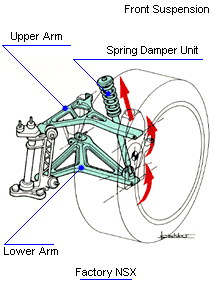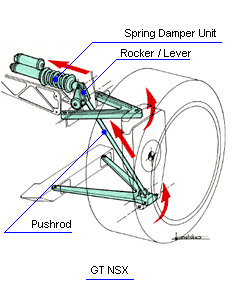This is an english translation of an original japanese article by Honda of Japan. The rights to this english translation belong to the Temple of VTEC Asia. All contents of this article are the intellectual property of Honda of Japan. Please refer to the main index page for further details.

Learn of the Secrets Unseen From the Grandstands
Volume 2 - Transplant a F1-Class Footwork
Lecturer: Akie Oku
*What is a Double-Wishbone?
The suspension is a very important part that decides the maneuverability of a car. The size and shape vary depending on the use and purpose of the car. The factory NSX has an impressive suspension that is designed to pursue high mobility and performance, which is a must for a pure-bred sportscar. The GT version NSX, however, requires a different suspension in order to win races. As a result, the GT-NSX's suspension is quite different from the factory NSX's suspension. Let us compare and contrast the two as we discuss this further.
 The factory NSX utilizes an in-wheel type double wishbone
suspension. "Double wishbone" refers to a suspension type
where one wheel is supported by two arms that support it from above
and below. Upon looking up an American dictionary, we find that,
"A wishbone is a bird's ribcage." Folklore has two people
pulling on each side of the rib, and whomever gets the longer half of the
ribcage "bone" would get their "wish". While its
naming comes from the visual similarities, it is a unique name for an
automotive part.
The factory NSX utilizes an in-wheel type double wishbone
suspension. "Double wishbone" refers to a suspension type
where one wheel is supported by two arms that support it from above
and below. Upon looking up an American dictionary, we find that,
"A wishbone is a bird's ribcage." Folklore has two people
pulling on each side of the rib, and whomever gets the longer half of the
ribcage "bone" would get their "wish". While its
naming comes from the visual similarities, it is a unique name for an
automotive part.
For the automobile, we cannot have the wishbone breaking on us, so a very sturdy pair of arms connects the tire to the car. The two ends of the wishbone are connected to the car, and the tip is connected to the wheel. By having one on top of the other, this sets up a "double" wishbone setup. The two arms are referred to as "upper arm" and "lower arm."
*A Unique Factory Suspension
When compared to other suspensions, a double wishbone suspension is more complex and requires more parts, but adjusts the wheel position wonderfully despite changes in road condition. Because it performs the basic needs of a suspension on a high level, race cars and luxury production cars often make use of it. With the current Formula 1, using a double wishbone setup for both the front and back is an obvious choice. The factory NSX also pursues such accurate handling, and utilizes the double wishbone suspension setup.
However, the phrase "double wishbone" does not cover all variants. The factory NSX utilizes a "In-Wheel" type double wishbone suspension. In this setup, the wishbone arm extends well into the wheelwell. The most noticeable, visual difference is that the arm itself no longer takes on a triangular shape. Instead, it looks as though an extra arm is attached beyond the triangular arm. (see illustration below) What this does, is that the car will gain all the advantages of the double wishbone suspension, but in addition, gain the ability to lower the overall height of the suspension, and the chassis. In order to make a factory car like the NSX hug the ground like it does, the in-wheel, double wishbone suspension was a must

Incidentally, the diagonal, narrow pipe with an attached spring is known as the spring damper unit. Typically, the spring damper unit's lower end is attached to the lower arm, and the upper end is connected to the chassis. The spring here supports the weight of the car, and expands and compresses depending on chassis position. During such motion, the dual wishbone arms will also move up and down, while being attached to the chassis.
*Different Thinking upon Conversion from Factory NSX to GT
The GT version is made with different objectives from the factory NSX, so modifications must be made in order to satisfy those goals. First off, wider tires will be used for racing, so the suspension will have to accommodate such changes. In addition, the suspension must be adjustable, so that the car may be raced on varying racing conditions. On the other hand, such considerations required for a factory car, such as development time, cost, ease of assembly are not a high priority.
So, under such conditions, the factory NSX was to be converted to a GT version. During the initial stages, the factory NSX's well-developed, in-line, double wishbone suspension became an obstacle. The All-Japan GT Racing Association rules state that when creating a GT car, one must retain the original suspension setup of the factory model. Fortunately for the NSX, it already came equipped with a double wishbone suspension -- this was not a problem.
However... As mentioned before, the GT-NSX would require wider racing tires. In order to accommodate for the larger tires, regulation allows for small modifications, such as allowing the fenders to be widened by 50mm on each side. However, the factory NSX had already pulled many tricks out of the hat, such as the in-wheel, double wishbone setup. There simply was no more space to work with. In order to make things work while preserving the double wishbone setup, a radical design change had to be made.
*Much Like the F1 - Use a Pushrod
Please see the image below. As you can see, the GT-NSX utilizes normal-looking upper and lower arms. They are almost triangular, and quite simple -- much like the ones used for Formula 1 cars. The gap in-between the upper and lower arms is to provide more leverage to support the larger wheels, which will be turning faster, and harder.

The factory NSX had the spring damper attached to the lower wishbone arm, but that is not the case for the GT-NSX. Instead, a metal rod is attached to the lower arm -- this is called a pushrod. At the upper end of the pushrod, there is a small lever, and on the opposite side of the lever, there is a spring dampening unit -- sideways. When driving, and the wheel gets an upward motion, the lower arm moves upward, causing the pushrod to move up as well. The lever is activated, and the spring damper unit gets compressed. As you may have noticed, this is the exact same setup used in modern-day Formula 1 cars.
By inserting an additional pushrod and moving the damper around, it is obvious that the overall structure is more complex, and involves more parts. However, the pushrod suspension system offers many advantages. First, because the spring damper unit does not lie to the side of the chassis, but within, it provides a greater level of freedom when designing the suspension area. Depending on the size and position of the upper and lower arms, the maneuverability changes greatly -- because of that, greater freedom during the design phase will translate into more ideal maneuverability.
Also, by placing the spring damper sideways on the top half of the chassis, it becomes easier to adjust the suspension settings. With a factory car, suspension components are rarely swapped out to make minor adjustments. However, with a race car, many adjustments are made to the setup -- often involving swapping parts. The easier it is to swap these parts out and make these adjustments, the more time one has to spend making further adjustments by testing them out on the track. Ease of adjustability is important enough that it will translate into a faster race car.
In addition, by placing the spring damper sideways, and on the top of the chassis, structural benefits are reaped, too. When the spring damper is installed diagonally, as with the factory NSX, the chassis must be reinforced to absorb and dissipate that diagonal force. With the factory NSX, there is no problem with doing this, but with a race car, designers are desperate to trim even one gram of excess weight. Keeping that in mind, note that the horizontally opposing spring dampers essentially cancel each other's shock force, reducing the need to additionally reinforce the chassis, and yielding in weight reduction.
Some refer to the GT-NSX as "A Formula 1 race car inside." I can say that at least for the suspension setup, that statement isn't too far-fetched. Of course, we have yet to explore the rest of the car. We'll talk about engines next.
| INDEX | ||
| NEXT |
Updated November 15, 1999